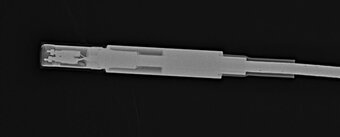192Ir brachytherapy source dosimetry using a microdiamond detector, with the help of Monte Carlo simulations
Project description: Brachytherapy is a form of radiotherapy treatment in which one or more radioactive sealed sources are placed inside or in the close proximity of a target tumor. For the correct outcome of a treatment, it is necessary to deliver appropriate radiation doses to the tumor sparing as much as possible the surrounding healthy tissues. Thus, it becomes very important to acquire an accurate knowledge of the dose delivered by the different kinds of brachytherapy sources. To this aim, one could make use of measuring devices such as radiation detectors and/or computational methods.

X-ray image of the microdiamond detector. These images can be very useful to estimate more exactly the relative positions and dimensions of the detector´s internal components.
Among the latter, Monte Carlo methods revealed to be an effective tool to calculate the absorbed dose from brachytherapy sources. Monte Carlo methods are computational algorithms able to provide numerical results of physical interactions occurring with a certain probability, such as the interaction of photons with matter. These methods applied to particle transport were first developed in the 1940s at the Los Alamos National Laboratory (Los Alamos, New Mexico, United States) by Stanislaw Ulam, John von Neumann, Robert Richtmeyer and Nicholas Metropolis.
Monte Carlo methods can be used to simulate in details real experiments when the actual performance of the experiment itself is made prohibitive for technical and/or logistical reasons. The results of the simulations provide valuable information about the role played by all the components of the experimental setup as well as about the response of radiation detectors. In this way, one can deduce valid indications for building a reliable setup in real applications.

Section of Monte Carlo simulation geometry. The 192Ir source (deep blue cylinder at the center of the picture, num.1) is at the center of the water tank (here represented by the green background). The source is placed inside a round needle (pale blue long cylinder, num.2). The source and the catheter are kept stable by a holder made of PMMA (num.3). The microDiamond sensitive volume (thin pale blue disk, num.4) with all its shielding and surrounding materials forming the whole detector is the on the right side of the picture (the deep blue cylinder with red stripes at the edges, num.5).
This research project focuses on performing 192Ir brachytherapy source dosimetry in water, both experimentally and with Monte Carlo simulations. The source is a High Dose Rate (HDR) 192Ir brachytherapy source model mHDR-v2r (Nucletron B.V., Veenendaal, The Netherlands). For the dose measurements (real and simulated) we use a microDiamond detector, developed at PTW laboratory (Freiburg, Germany). The purpose is to investigate the microDiamond suitability for brachytherapy dosimetry. This detector has in fact several promising characteristics, such as: small sensitive volume (0.0038 mm3) made of a synthetic single crystal diamond, near water-equivalence (i.e. the radiation interacts with the detector almost as if it was made of water) and waterproof qualities (see fig.1).
The experimental part of this project consists in measuring the absorbed dose to water from the source at different distances and angles. Both the source and the microDiamond are immersed in a water tank (PTW MP3 water phantom). In this way we measure all the dosimetry parameters which are used by treatment planning systems to calculate the dose to patients.
At the same time, we reproduce the experiments running simulations with the Monte Carlo code MCNP6®, developed at Los Alamos National Laboratory. This code allows for transport of photons, neutrons, electrons and also for coupled neutron/photon/electron transport. Monte Carlo simulations will help us better understand the response of the microDiamond to radiation and investigate possible effects from all the components of the experimental setup which could influence our results (see fig.2).
Finally, we compare the results with the currently accepted dosimetry dataset for our source. The possibility to employ the microDiamond detector for accurate dose measurements in brachytherapy would be very beneficial, giving a contribution to the improvement of quality and safety of treatment on patients.

